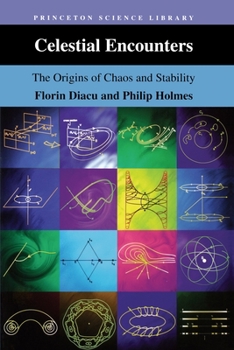Celestial Encounters: The Origins of Chaos and Stability
Select Format
Select Condition 
Book Overview
Celestial Encounters is for anyone who has ever wondered about the foundations of chaos. In 1888, the 34-year-old Henri Poincar submitted a paper that was to change the course of science, but not before it underwent significant changes itself. "The Three-Body Problem and the Equations of Dynamics" won a prize sponsored by King Oscar II of Sweden and Norway and the journal Acta Mathematica , but after accepting the prize, Poincar found a serious mistake in his work. While correcting it, he discovered the phenomenon of chaos. Starting with the story of Poincar 's work, Florin Diacu and Philip Holmes trace the history of attempts to solve the problems of celestial mechanics first posed in Isaac Newton's Principia in 1686. In describing how mathematical rigor was brought to bear on one of our oldest fascinations--the motions of the heavens--they introduce the people whose ideas led to the flourishing field now called nonlinear dynamics. In presenting the modern theory of dynamical systems, the models underlying much of modern science are described pictorially, using the geometrical language invented by Poincar . More generally, the authors reflect on mathematical creativity and the roles that chance encounters, politics, and circumstance play in it.
Format:Hardcover
Language:English
ISBN:0691027439
ISBN13:9780691027432
Release Date:November 1996
Publisher:Princeton University Press
Length:256 Pages
Weight:1.20 lbs.
Dimensions:0.9" x 7.8" x 10.0"
Customer Reviews
5 ratings
A VALUABLE BOOK ON NONLINEAR DYNAMICS
Published by Thriftbooks.com User , 20 years ago
Most popular books on scientific topics are by professional writers who know how to construct interesting narratives but don't really understand the science. Thus they are overly impressed by those whom they have recently interviewed, remaining ignorant of the broad picture and history of their subject. Seldom does one come across a well-written book for the general public by scientists, but "Celestial Encounters" is an exception to this general rule. Both of the authors (Florin Diacu and Philip Holmes) are distinguished researchers in the area of nonlinear science and also fine writers. Thus the reader is ever in good hands as the technical parts of the book are not dumbed down; the more technical sections (which can be skipped in a first reading) are correctly and carefully written in simple English. Anyone reading through this book will come away with greater understanding of the famous N-body problem of celestial mechanics - including both the history and how it fits into the fabric of modern mathematics, particularly in connection with the development of nonlinear dynamics and the modern theory of chaos. The historical perspectives presented are particularly vivid and informative. I don't know where one would find a more interesting and better informed discussion of the curious events surrounding the award of the 1889 mathematics prize by King Oscar II of Sweden to Henri Poincaré.
Ecxellent presentation, exciting subject
Published by Thriftbooks.com User , 25 years ago
The book is a great pleasure to read. The style is light and profound at the same time. It talks to a sientifically mature reader but does not sacrifice the simplicity and the elegant clarity of the exposition. History and mathematics are well balanced. What I liked, probably, the most was that the process of scientific discovery is described is highly emotional (and as a scientist I share the same sentiment). It's also nice to see that Eastern European mathematicians received a fair credit here, which does not happen too often in histories of mathematics published in the States.
A nice historical and mathematical introduction to Chaos
Published by Thriftbooks.com User , 25 years ago
It is a complete history of Dynamical Systems theory and at the same time an exposition of the mathematical ideas involved in this theory. An excellent introduction for beginers, and a good panoramic vision for people interested in science.
It was a dark and stormy seminar...
Published by Thriftbooks.com User , 27 years ago
If you enjoy math and astronomy-related topics and are curious about the history of some fascinating 20th century discoveries concerning the n-body problem, this book should satisfy you. Warning: this book could also annoy you, if you are the least bit sensitive to empty calories such as: "Napolean gazed deeply into Laplace's eyes...", which liberally lard up the text.
Marcel Munta,University of Muenchen,Germany
Published by Thriftbooks.com User , 28 years ago
O placuta si interesanta carte de istoria matematicii,accesibila si profanilor in materie,scrisa cu verva si extrem de bine documentata





